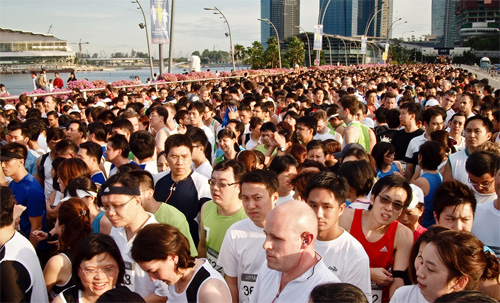The JP Morgan Corporate Challenge—running for teamwork, fitness, charity and a greener tomorrow.
 |
|
| CN PHOTO: Jere Chong | |
Some 12,000 rubber-soled individuals from 369 organizations took to the streets at 6 p.m. on May 7 for the seventh annual JP Morgan Corporate Challenge, a 5.6 km road race that started at the Esplanade Bridge, traversing Raffles Avenue and Republic Avenue before ending at the Formula One Pit Building near the Singapore Flyer.
Part of the 12-city JP Morgan Chase Corporate Challenge Series involving New York, London, San Francisco and Sydney, the Singapore leg of the race, which has been a sold-out event for the past four years, saw an 18 percent increase in participants from the previous year, in line with the rising trend of endurance activity locally.
The idea for the JP Morgan Chase Corporate Challenge was birthed when several bank officials wanted to create an event solely for corporate runners, at a distance which even busy executives would have time to train for—3.5 miles, or 5.63 km. And while it started off as a single race in New York in 1977 with 200 runners from 50 companies, it has grown into one of the world’s most popular sporting events for the corporate community. Last year, the event drew a worldwide number of 221,704 participants from 7,731 companies and donated more than S$600,000 to local charities.
The race has also grown in its objectives, beyond that of promoting fitness at the workplace. Latching on to the buzz of the corporate social responsibility concept, the race carries an environmental message, with this year’s theme being Teaming Up For A Greener Tomorrow. Aiming to be the “greenest” road race in the world, all 12 series of the race in the various countries have been adopting green practices such as having finisher T-shirts printed with soy-based ink, leveraging on online means to conduct registration and encouraging all participants to travel to events via provided shuttle or public transportation.
Charity donations will also be made through the JP Morgan Chase Foundation to the Asian Civilisations Museum and MILK: Mainly I Love Kids. The funds, collected as a portion of the entry fees, would be used to help benefit a feature tour, ImaginAsia, for children from low income families, single-parent homes and orphaned children or those with no legal guardian. For the latter, the funds will benefit disadvantaged children and youth both locally and overseas through education, care and guidance as well as vocational and livelihood development, among others.
As such, not all participants were pounding the asphalt—some were just casual walkers looking to bond with their colleagues beyond the office cubicle. StarHub led the largest contingent with 511 participants, followed by PriceWaterhouseCoopers with over 400 runners. Citibank as well as Credit Suisse and Cisco Systems were among many that turned up.
For me, the race not only helped me keep fit but allowed me to socialize with my colleagues and help the disadvantaged. Also, I was able to proudly say to my children that night that Daddy has helped keep the earth greener for their future.
If you’re interested to participate in next year’s race, here are the benchmarks for you to work towards—from the men’s category, Ian Stuart from Vestas Asia Pacific crossed the finish line in 19 minutes 24 seconds, while Vivian Tang from CIMB-GK Securities clocked in at 21 minutes 42 seconds, in the women’s category.
Kenneth Koh is a volunteer writer for City News.
